Every culture has a distinctive cuisine and the Middle East is no exception. Rich, filling, buttery and luscious are all words that can describe the wonderful creations of the Middle East. Despite the Middle East’s cultural diversity, it’s cuisine has a level of homogeneity that can be seen in the popular use of olive oil, parsley, pitas, sesame seeds, chick peas, mint and rice. Presented are some of the most delicious plates of the Middle East.
“What is your favorite Middle-Eastern dish out of these three? Let us know by choosing one of the options below!”
1) Ful Medames:
“The rich man’s breakfast, the shopkeeper’s lunch, the poor man’s supper,” a traditional Arabic saying used to describe this popular warm dish.
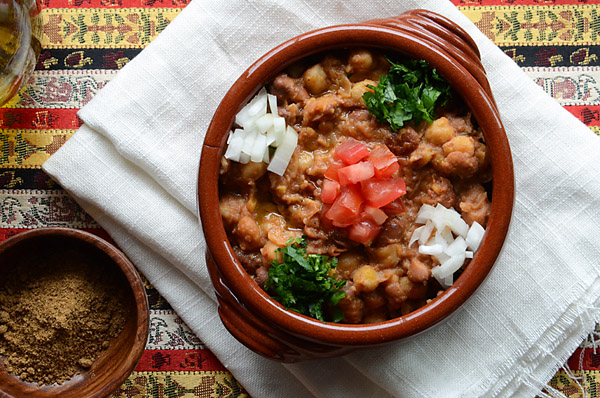
Ful Medames or simply Ful is a dish made of mashed Fava beans. This salty filling dish can be eaten in almost every meal. Ful is usually eaten plain or salty. There are a number of ways to prepare ful, yet, the most basic method is prepared almost the same. It is usually cooked with olive oil, cumin, and could be served or garnished with Tahini (see number 15) chopped onions, garlic, parsley, lemon juice, or tomato sauce. The popular Egyptian dish is usually eaten with baladi bread (pita bread) and fried or boiled eggs.
Many Arab and Middle Eastern Cultures have adopted this widespread dish and it could be found in almost every Middle Eastern restaurant or street vendor.
Interesting fact: Ful is an Egyptian dish that dates back to the time of Ancient Egypt. It is said that Ramses II of Egypt offered the god of the Nile River 11,998 pots of fava beans.
2) Falafel:
“The original veggie burger”
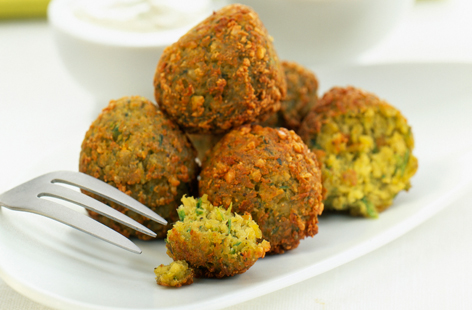
The origin of this mouthwatering dish is unknown, yet, Palestinians have claimed that Falafel, known as Taamiya in the Middle East, originated on their soils. Made from chickpeas, fava beans or both, Falafel is often thought of as the fast food of the Middle East.
Falafel balls or patties are often eaten in pita bread and topped with pickled vegetables, hot sauce and drizzled with tahini. This combination of ingredients makes for a crunchy bite and nutty taste with the addition of tahini. Falafel can also be eaten alone and can be served as an appetizer.
Interesting fact: The largest falafel ball was prepared in Amman, Jordan weighing at a massive weight of 74.75 kg (164.4 lb).
3) Mulukhiyya:
“The one dish bonding generation after generation”
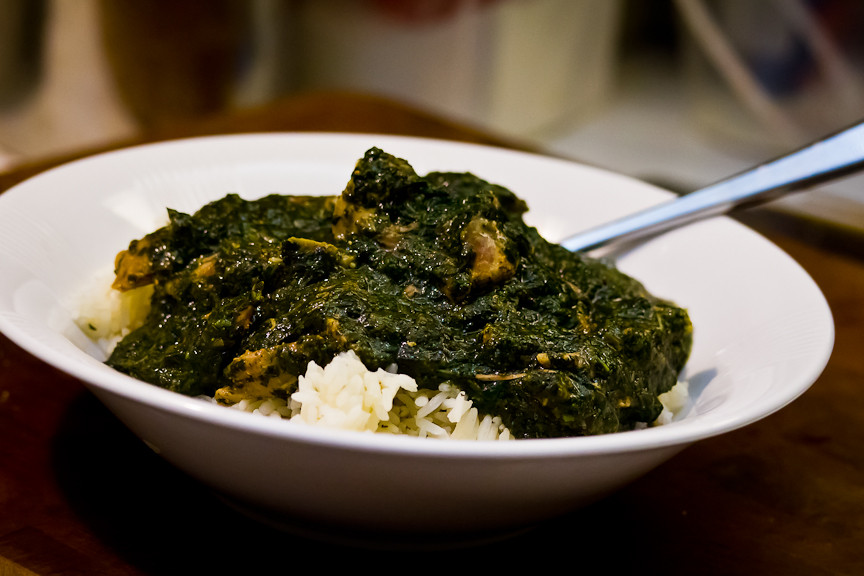
Eaten in both Ancient Egyptian and Chinese cultures, Mulukhiyya is a staple dish in the Middle East. Egyptian or Chinese it doesn’t matter! This leafy green soup, which is often mistaken for spinach, is regarded as one of the national dishes in Egypt. You can often hear Arabs speak highly of their mother’s or grandmother’s version of this delicious dish.
Often described as “slimy”, Mulukhiyya is the leaves of Corchorus species (Jute leaves) boiled to make a mucilaginous broth. Mulukhiyya is prepared by removing its central spine and chopped finely with garlic and coriander. Yet, some cultures do not chop the leaves finely. In Lebanon, Mulukhiyya is not chopped finely rather left to its original shape and often fried with coriander, garlic and red spices.
This vegetable dish is often poured over rice or cut pita bread and served with chicken or rabbit. Some cultures also use red meat in preparation of this dish.
Interesting fact: This delicious dish was featured on a banned list of foods by the sixth Caliph of Fatimid Dynasty – Al – Hakim bi-Amr Allah, who historians believe was abducted on a journey by people who opposed the banning of this scrumptious stew and other tasty dishes.
4) Fatteh:
“The celebration meal!”
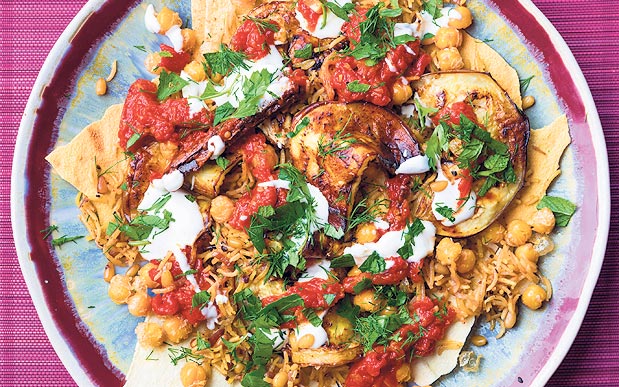
Often eaten in family reunions and large get-togethers, fatteh is a Damascene dish that is very popular in Egypt and in the Southern Levant area (a land that comprises Damascus, Beirut, Jordan and Palestine). Fatteh is a dish that comprises a bed of broken up toasted or fresh bread as a base for additional toppings. Some cultures, add meat, chickpeas, rice, strained yoghurt, hummus (see number 15) and eggplants, however, this tasty dish could also be eaten with chicken. Pine nuts are also used to garnish fatteh.
There are many variations to this delectable dish as many cultures have adopted different ways to prepare fatteh some of the most popular being the Egyptian, Syrian and Lebanese versions.
Interesting Fact: This dish comprises various textures, tastes and temperatures all served together in one bowl, not to mention its intriguing flavors!
5) Kushari:
“The national dish of Egypt”
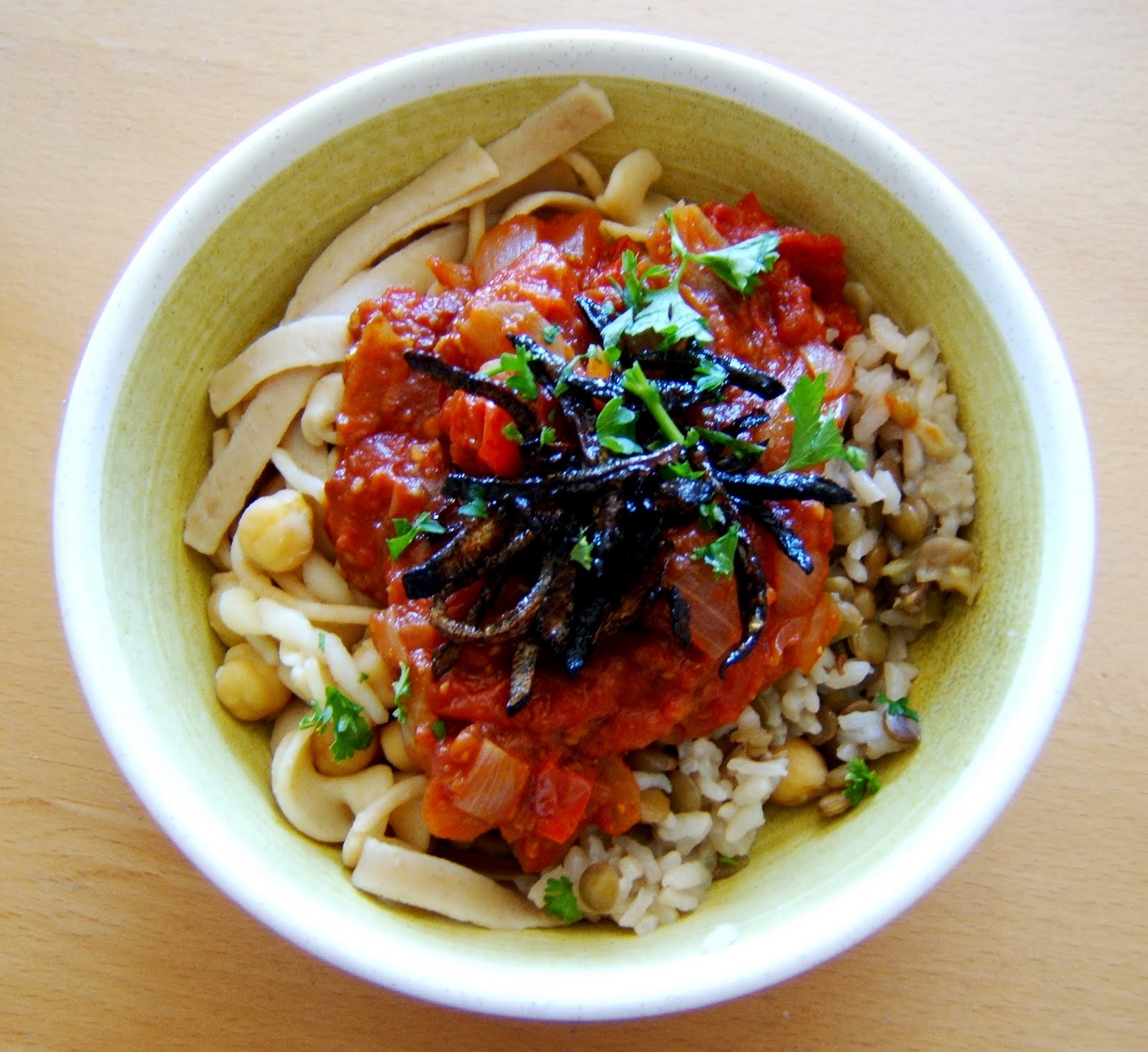
It is not secret that Egyptian food is a combination of several cultures blended nicely into one, yet, what makes Egyptian food so interesting is the special ‘Egyptian Touch’. The “Egyptian touch” is a saying that often falls into context when Egyptians try to turn or add to something to make it their own. In this case, Kushari is a dish believed to have come with the British soldiers in the 19th century, in which the rice came from Asia, the pasta from Italy and the tomatoes from Latin American. However, the idea to combine all of those ingredients into one falls again under the concept of the “Egyptian touch.”
This filling and appetizing dish consists of four different carbohydrates and is considered one of Egypt’s most popular street food, along with ful and falafel. Kushari consists of pasta, tomato sauce, rice, lentils, caramelized onions, garlic, spicy sauce and chickpeas.
Interesting fact: Some believe Kushari, both inexpensive and filling, originated in India and came with the British soldiers. The Indian dish, which is called Kitchari, is a dish made of rice, lentils and spices. It wasn’t long before Egyptians embraced this dish and made it their own!
6) Shawarma:
“The Middle Eastern burrito”
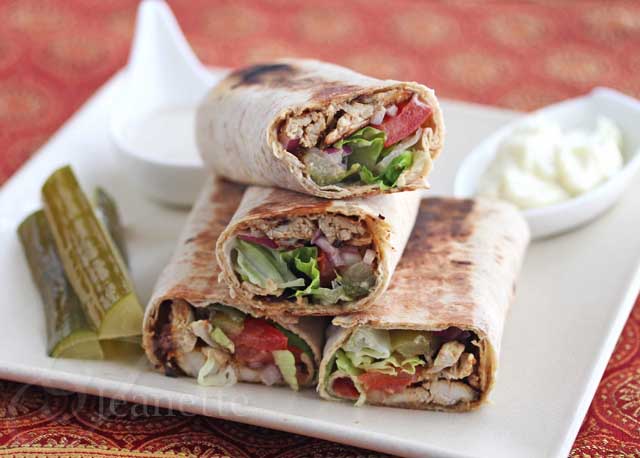
A Flavorful and pleasing blend of meats, pickles, vegetables and different Middle Eastern sauces, shawarma may be regarded as the Middle Eastern version of a wrap or a burrito. Usually wrapped in taboon bread, lavash bread or pita bread, shawarma is topped with tahini, hummus or toumiya (garlic dip). Nevertheless, this luscious blend of meats and juicy toppings is exceptionally popular in the Middle East and Turkey.
Interesting fact: A competition to the Middle East’s fast food choices, shawarma is said to have originated from a Turkish dish called döner kebab.
7) Couscous:
“The pasta of North Africa”
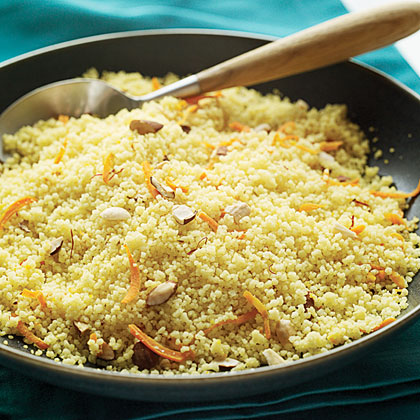
Contrary to popular belief, couscous is not a grain. Its rice-like appearance often confuses people. Couscous is made of some of the same components of pasta which are semolina and wheat flour. This easy-to-make diverse dish is a staple among North African cuisines. Couscous is usually steamed; however, today couscous is sold in packages of pre-steamed and dried products that only require a few minutes of boiling.
Couscous can be eaten as a sweet or savory dish, and can also be eaten as a main or side dish. Meats, vegetables, spices, pickles, or fruits, sugar, and nuts can be added to this nutritious dish. Its diverse usage makes it easy to please just about any palette.
Interesting fact: Couscous was voted as the third favorite dish among French people in 2011, and the first in the east of France.
8) Dolma:
“Mr. Worldwide”

Most people believe that Dolma was introduced to Egypt with the Ottoman Empire. Dolma is a variety of stuffed vegetables dishes that are very common in the Middle East. Dolma often refers to the paste or stuffing inside the vegetables. Some of the vegetables used in this luscious hearty dish are: tomatoes, bell peppers, onions, zucchinis, and eggplants. Dolma can also be wrapped in cabbage or grape leaves (waraq enab). They can be served cold or warm; however, when served cold it is usually served without meat and as a side dish.
Interesting fact: Dolma is found in Armenian, Azerbaijan, Bangladesh, Cypriot, Egyptian, Greek, Iranian, Iraqi, Israeli, Palestinian, Polish, Romanian, Swedish, and Turkish cuisines.
9) Maqluba:
“The up-side down dish”
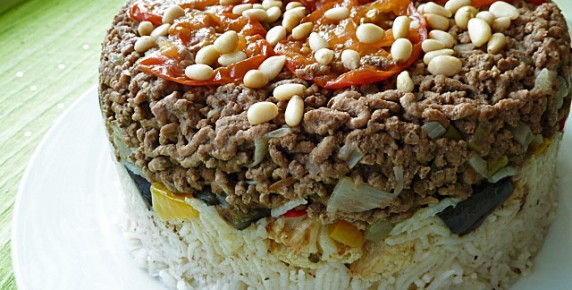
Maqluba is a traditional Arab, Levant, and Persian dish, which originated in Palestine. A beautiful nutritious dish, Maqluba consists of several food staples: rice, meat and vegetables. The name Maqluba means “upside-down.” It refers to the way the dish is eaten. The vegetables, meat and rice are layered in a pot and turned upside-down when serving.
Due to its cultural diversity, there are many ways to make Maqluba. Yet, usually eggplant, cauliflower, onions, potatoes and tomatoes are used as the vegetables of the dish and ground lamb, beef or chunks of chicken are added as the meat portion of the dish.
Interesting fact: In Turkey, this dish is called “Maklubeh.” Maqluba or Maklubeh can be eaten as a vegetarian dish by omitting the meat and adding nuts.
10) Mansaf:
“The national dish of Jordan”
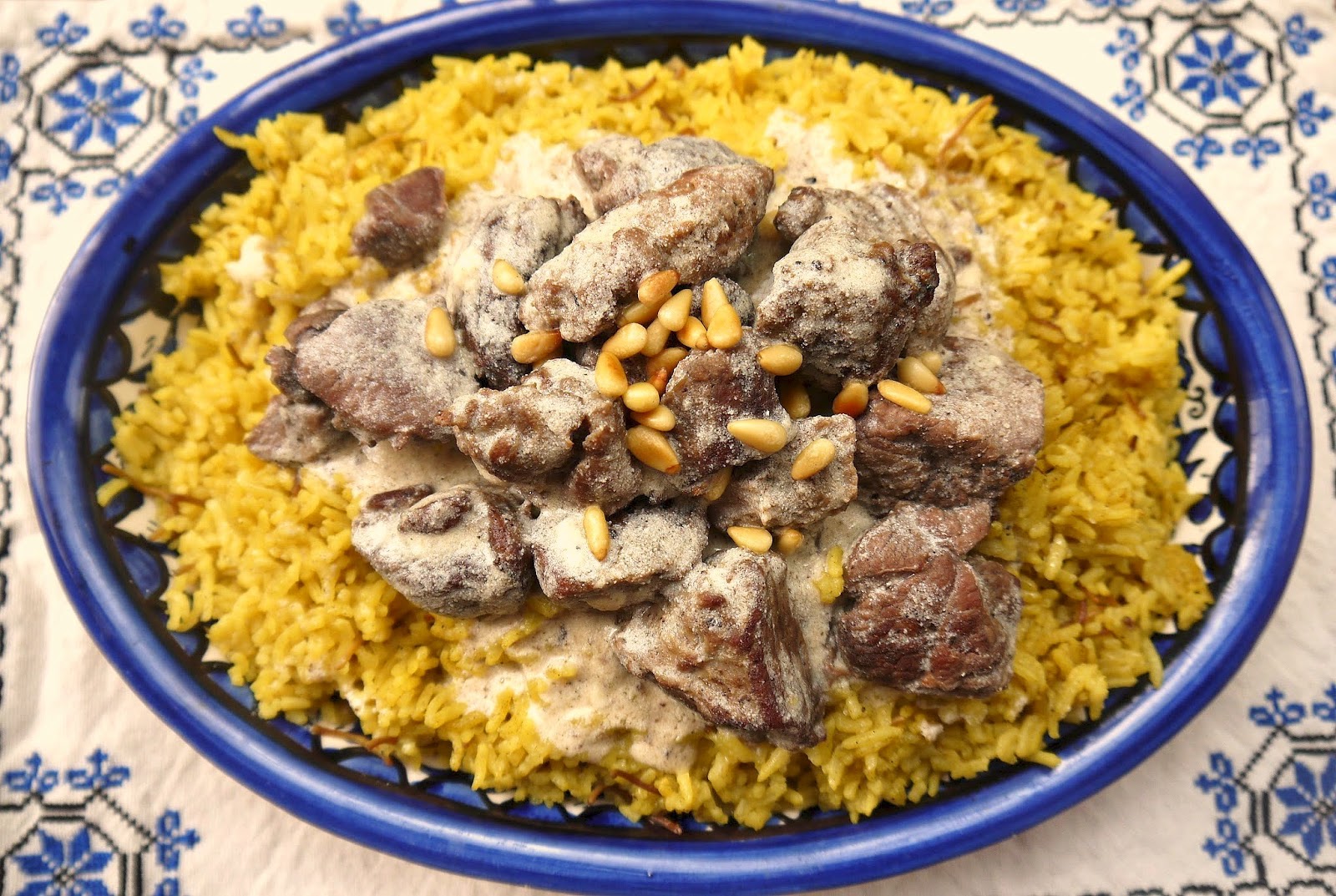
Mansaf is a Jordanian dish made of lamb chunks cooked in a fermented dried yoghurt product called “Jameed” and poured over rice. The dish is usually served in a big utensil and is layered over flat bread.
Regarded as the national dish in Jordan and one of the most popular dishes served, Mansaf plays a huge cultural role in Jordanian traditions. It is often served on special occasions like weddings, births, and main Islamic holidays. Much like the Fatteh, it is also a “celebration meal.” Traditionally, it is eaten with the right hand without using utensils and is served in a large Bedouin style platter.
Interesting fact: Traditionally, Mansaf did not have rice in it. Rice was introduced to Jordan in the twentieth century, however, Mansaf dates back beyond that. Years ago, Mansaf was served with grounded wheat which is called “Jarish” in Arabic and flat bread called “Shrak”.
11) Kishk:
“The savory rice pudding”

Kishk is an Egyptian creamy rice pudding dish often served with caramelized onions and poured over rice or eaten with pita bread. A relatively easy to make dish, Kishk is the product of lemon juice, creamy white sauce and tomato sauce together. It is often eaten with chicken.
Interesting fact: Kishk uses yoghurt as the base for the white sauce.
12) Sharkaseya:
“A dish fit for royals”
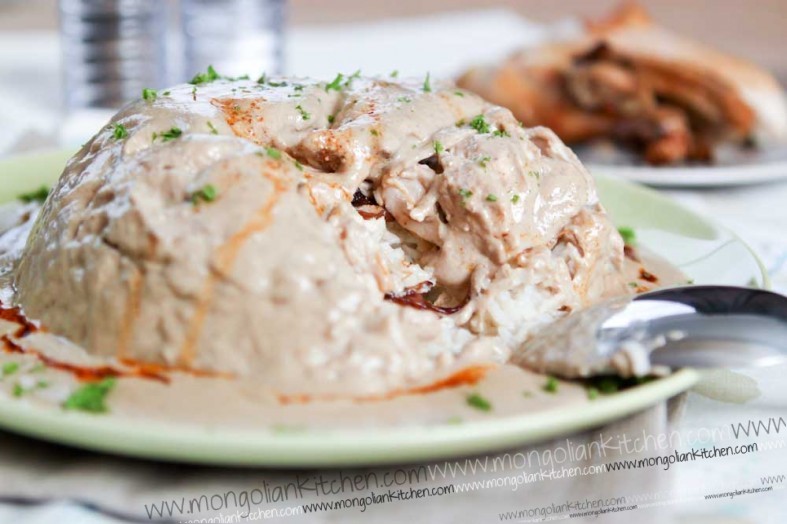
Much of the Middle East is greatly influenced by the Ottoman Empire and this dish is no exception. A popular dish among Arabs, it is believed that Sharkaseya is a Turkish dish that was introduced to the Middle East through the Ottoman Empire.
Sharkaseya is a dish made of a creamy buttery walnut sauce poured over chicken and rice. It is often served in huge quantities and poured in big utensils. Some people use freek (barley) instead of rice. It is garnished with pine nuts and walnuts.
Interesting fact: It was regarded as the dish of Royals because it was often eaten among Turkish-origin rulers in the Middle East.
13) Manakeesh:
“The Middle Eastern pizza”
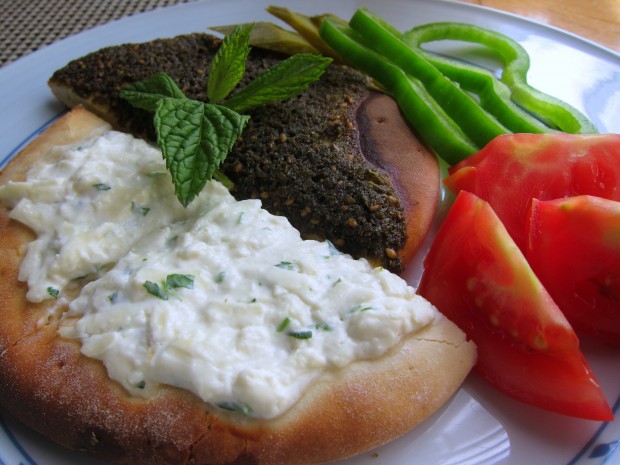
This Levantine dish is Lebanon’s favorite breakfast. Made of dough, Manakeesh is a round piece of pastry that is often topped with Zaatar (thyme, sumac and sesame seeds), cheese and olive oil. Manakeesh can be topped with all kinds of meat and cheese. It can be eaten for breakfast or lunch. It is sometimes referred to as Manousheh since Mounsheh is the singular of Manakeesh.
Shaped like a pizza and made of dough, Manakeesh is regarded as the Middle Eastern take on a pizza. A Mounsheh is often round, however; more modern variations of this dish do not stick to its original shape. Now, Manakeesh or Manousheh can be found in street vendors in the form of a wrap or an appetizer in restaurants.
Interesting Fact: This is such a popular dish and is so prevalent in Lebanon that there is a manakeesh baker in almost every borough, village or neighborhood. It is one of Lebanon’s staple dishes, which is why it is often mistaken as Lebanese in origin. However, it is said that Manousheh originated in Palestine.
14) Kibbeh:
“The Middle Eastern meat balls”

Kibbeh or Kobeiba is a Middle Eastern dish made of Bulghur (cracked wheat), ground meat, and minced onions. Usually eaten as a fried croquette, kibbeh is often shaped as a torpedo and can be eaten as a side dish or an appetizer.
In Levantine dishes, Kibbeh can be stuffed with lamb meat instead of beef. This dish is Syrian in origin; however, it is very popular all over the Middle East. There are many variations to this dish: it can be shaped differently and is not necessarily fried everywhere. Some cultures bake the kibbeh instead of frying.
Interesting Fact: During WWII, British soldiers used to call this dish “Syrian torpedoes.”
15) Mezeh:
“The essentials of every meal”

Mezeh refers to a collection of small dishes that were often eaten to accompany alcoholic beverages. However, today, they are eaten as appetizers to large scale dishes. It is worth mentioning that Ful, Kibbeh, Dolma and Falafel can be eaten as Mezeh.
Tabouleh: This fresh dish is made of bulghur, parsley, tomatoes, mint and onions and is dressed with olive oil, lemon juice and salt. Some variations of this dish add couscous and lettuce to tabouleh.
Fattoush: The bread salad, as some call it, Fattoush is a salad made from toasted pita bread and mized greens.
Humus: The famous Middle Eastern hummus has recently been a favorite of foreign countries. It is made of mashed chickpeas, tahini, lemon juice, garlic and olive oil.
Baba Ghanoush: is a Levantine dish made of eggplant paste, onions, tomatoes, olive oil and various seasonings. Baba Ghanoush can also have tahini.
Tahini: Tahini, or Tahina as some call it, is a very famous dip made from ground sesame seeds. It is a major component of Hummus and Baba Ghanoush.
Labna: Labna is often eaten like a cheese product, however, it is strained yoghurt that has a very sour taste and a thick texture.
Halloumi Cheese: Halloumi has recently become popular in the US. It is a semi-hard brined cheese made from sheep’s and goat’s milk, and recently, is made from cow’s milk.






Comments (31)
That’s what we daily deal with !
can you share with us where we can find those dishes aound kaherah,(specific place)
i think this link will help you 🙂
http://www.140online.com/Class/En/502/Oriental%20%20Restaurants
Fantastic article. All dishes selected by the article are mouth watering!
Check out a great way how_ you can earn a lot of extra $ by finishing basic jobs online from home for few hrs /daily VISIT MY-DISQUS-PROFILE to find out more